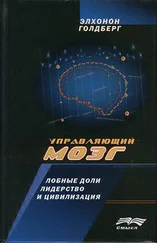2. E. Goldberg, «The Gradiental Approach to Neocortical Functional Organization», Journal of Clinical and Experimental Neuropsychology 11 (1989): 489–517; E. Goldberg, «Associative Agnosias and the Functions of the Left Hemisphere», Journal of Clinical and Experimental Neuropsychology 12 (1990): 467–484; E. Goldberg and W. Barr, «Three Possible Mechanisms of Unawareness of Deficit», in Awareness of Deficit: Theoretical and Clinical Issues, Eds. G. Prigatano and D. Schacter (New York: Oxford University Press, 1991): 152–175.
3. H. Hecaen and M. L. Albert, Human Neuropsychology, Hardcover (New York: John Wiley & Sons Inc., 1978); A. Luria, Higher Cortical Functions in Man (New York: Basic Books, 1980); E. Goldberg, «Associative Agnosias and the Functions of the Left Hemisphere», Journal of Clinical and Experimental Neuropsychology 12 (1990): 467–484.
4. A. Luria, Higher Cortical Functions in Man (New York: Basic Books, 1980); E. Goldberg and W. Barr, «Three Possible Mechanisms of Unawareness of Deficit», in Awareness of Deficit: Theoretical and Clinical Issues, Eds. G. Prigatano and D. Schacter (New York: Oxford University Press, 1991): 152–175; R. C. Leiguarda and C. D. Marsden, «Limb Apraxias: Higher-Order Disorders of Sensorimotor Integration», Brain 123 (2000): 860–879.
5. O. Sacks, The Man Who Mistook His Wife for a Hat: And Other Clinical Tales (New York: Touchstone, 1998).
6. J. Capgras and J. Reboul-Lachaux, «Illusion des ‘sosies’ dans un délire systematize chronique», Bulletin de la Société Clinique de Médicine Mentale 2 (1923): 6—16.
7. N. Chomsky, Language and Mind, 3rd edn. (Cambridge, UK: Cambridge University Press, 2006); N. Chomsky, Syntactic Structures (Eastford, NJ: Martino Fine Books, 2015).
8. R. W. Byrne, «Human Cognitive Evolution», in The Descent of Man: Psychological Perspectives of Hominid Evolution, Eds. M. C. Corbalis and S. E. G. Lea (New York: Oxford University Press, 1999): 71–87.
9. N. Geschwind and W. Levitsky, «Human Brain: Left-Right Asymmetries in Temporal Speech Region», Science 161 (1968): 186–187; A. L. Foundas, A. Weisberg, C. A. Browning, and D. R. Weinberger, «Morphology of the Frontal Operculum: A Volumetric Magnetic Resonance Imaging Study of the Pars Triangularis», Journal of Neuroimaging 2001): 153–159.
10. A. Luria, Higher Cortical Functions in Man, 2nd edn. (New York: Basic Books, 1980); E. Goldberg, «The Gradiental Approach to Neocortical Functional Organization», Journal of Clinical and Experimental Neuropsychology 11 (1989): 489–517.
11. A. Martin, C. L. Wiggs, L. G. Ungerleider, and J. V. Haxby, «Neural Correlates of Category-Specific Knowledge», Nature 379 (1996): 649–652; A. Martin, J. V. Haxby, F. M. Lalonde, C. L. Wiggs, and L. G. Ungerleider, «Discrete Cortical Regions Associated with Knowledge of Color and Knowledge of Action», Science 270 (1995): 102–105.
12. M. Cappelletti, F. Fregni, K. Shapiro, A. Pascual-Leone, and A. Caramazza, «Processing Nouns and Verbs in the Left Frontal Cortex: A Transcranial Magnetic Stimulation Study», Journal of Cognitive Neuroscience 20 (2008): 707–720.
13. S. M. Kosslyn, «Seeing and Imagining in the Cerebral Hemispheres: A Computational Approach», Psychological Review 94 (1987): 148–175.
14. For a comprehensive review of the subject, see: L. S. Rogers, G. Vallortigara, and R. J. Andrew, Divided Brains: The Biology and Behaviour of Brain Asymmetries (Cambridge, UK: Cambridge University Press, 2013).
15. Y. Yamazakia, U. Austb, L. Huberb, M. Hausmanna, and O. Güntürkün, «Lateralized Cognition: Asymmetrical and Complementary Strategies of Pigeons During Discrimination of the Human Concept», Cognition 104 (2007): 315–344.
16. K. Folta, B. Diekamp, and O. Güntürkün, «Asymmetrical Modes of Visual Bottom-Up and Top-Down Integration in the Thalamic Nucleus Rotundus of Pigeons», Journal of Neuroscience 27 (2004): 9475–9485.
17. J. W. Peirce and K. M. Kendrick, «Functional Asymmetry in Sheep Temporal Cortex», Neuroreport 13 (2002): 2395–2399; J. W. Peirce, A. E. Leigh, A. P. DaCosta, and K. M. Kendrick, «Human Face Recognition in Sheep: Lack of Configurational Coding and Right Hemisphere Advantage», Behavioural Processes 55 (2001): 13–26; J. W. Peirce, A. E. Leigh, and K. M. Kendrick, «Configurational Coding, Familiarity and the Right Hemisphere Advantage for Face Recognition in Sheep», Neuropsychologia 38 (2000): 475–483.
18. K. Guo, K. Meints, C. Hall, S. Hall, and D. Mills, «Left Gaze Bias in Humans, Rhesus Monkeys and Domestic Dogs», Animal Cognition 12 (2009): 409–418.
19. A. Ghazanfar, D. Smith-Rhorberg, and M. D. Hauser, «Role of Temporal Cues in Rhesus Monkey Vocal Recognition: Orienting Asymmetries to Reversed Calls», Brain Behavior and Evolution 58 (2001): 163–172; M. D. Beecher, M. R. Petersen, S. R. Zoloth, D. B. Moody, and W. C. Stebbins, «Perception of Conspecific Vocalizations by Japanese Macaques. Evidence for Selective Attention and Neural Lateralization», Brain Behavior and Evolution 16 (1979): 443–460; H. E. Heffner and R. S. Heffner, «Temporal Lobe Lesions and Perception of Species Specific Vocalizations by Macaques», Science 226 (1984): 75–76.
20. R. Hamilton and B. A. Vermeire, «Complementary Hemispheric Specialization in Monkeys», Science 242 (1988): 1691–1694.
21. N. Kriegeskorte, M. Mur, D. A. Ruff, R. Kiani, J. Bodurka, H. Esteky, K. Tanaka, and P. A. Bandettini, «Matching Categorical Object Representations in Inferior Temporal Cortex of Man and Monkey», Neuron 60 (2008): 1126–1141.
22. E. Goldberg, «The Gradiental Approach to Neocortical Functional Organization», Journal of Clinical and Experimental Neuropsychology 11 (1989): 489–517; E. Goldberg, «Higher Cortical Functions in Humans: The Gradiental Approach», in Contemporary Neuropsychology and the Legacy of Luria, Ed. E. Goldberg (Mahwah, NJ: Lawrence Erlbaum, 1990): 229–276.
23. G. Huth, S. Nishimoto, A. T. Vu, and J. L. Gallant, «A Continuous Semantic Space Describes the Representation of Thousands of Object and Action Categories Across the Human Brain», Neuron 76 (2012): 1210–1224.
24. G. A. Miller, «WordNet: A Lexical Database for English», Communications of the ACM 38 (1995): 39–41. У меня есть личный долг благодарности покойному доктору Миллеру, который дружески поддерживал меня в середине 1970-х годов, когда я проводил исследования в качестве приглашенного ученого в Университете Рокфеллера в Нью-Йорке, где у доктора Миллера была лаборатория в то время.
25. G. Huth, W. A. De Heer, T. L. Griffiths, F. E. Theunissen, and J. L. Gallant, «Natural Speech Reveals the Semantic Maps That Tile Human Cerebral Cortex», Nature 532 (2016): 453–458.
26. L. Miller, J. Cummings, F. Mishkin, K. Boone, F. Prince, M. Ponton, and C. Cotman, «Emergence of Artistic Talent in Frontotemporal Dementia», Neurology 51 (1998): 978–982.
27. W. Snyder, E. Mulcahy, J. L. Taylor, D. J. Mitchell, P. Sachdev, and S. C. Gandevia, «Savant-like Skills Exposed in Normal People by Suppressing the Left Fronto-temporal Lobe», Journal of Integrative Neuroscience 2 (2003): 149–158; A. Snyder, «Explaining and Inducing Savant Skills: Privileged Access to Lower Level, Less-processed Information», Philosophical Transactions of the Royal Society of London, B: Biological Sciences 364 (2009): 1399–1405.
28. E. Goldberg, D. Roediger, N. E. Kucukboyaci, C. Carlson, O. Devinsky, R. Kuzniecky, E. Halgren, and T. Thesen, «Hemispheric Asymmetries of Cortical Volume in the Human Brain», Cortex 49 (2013): 200–210; M. Harciarek, D. Malaspina, T. Sun, and E. Goldberg, «Schizophrenia and Frontotemporal Dementia: Shared Causation?» International Review of Psychiatry, 25 (2013): 168–177.
Читать дальше
![Элхонон Голдберг Креативный мозг [Как рождаются идеи, меняющие мир] [litres] обложка книги](/books/395572/elhonon-goldberg-kreativnyj-mozg-kak-rozhdayutsya-id-cover.webp)




![Наталья Царенко - Джентльменами не рождаются, или Секреты воспитания мальчиков [litres]](/books/396504/natalya-carenko-dzhentlmenami-ne-rozhdayutsya-ili-se-thumb.webp)






